Solved Example Problems | Mathematics - Value and Zeros of a Polynomial | 9th EM Mathematics : Algebra
Chapter: 9th EM Mathematics : Algebra
Value and Zeros of a Polynomial
Value and Zeros of a Polynomial
Consider the two graphs given below. The first is
linear, the second is quadratic. The first intersects the X axis at one point (x =
–3) and the second at two points (x =
-1 and x = 2) . They both intersect the
Y axis only at one point. In general, every polynomial has a graph and the graph is shown as a
picture (since we all like pictures more than formulas, don’t we?). But also,
the graph contains a lot of useful information – like whether it is a straight
line, what is the shape of the curve, how many places it cuts the x-axis, etc.
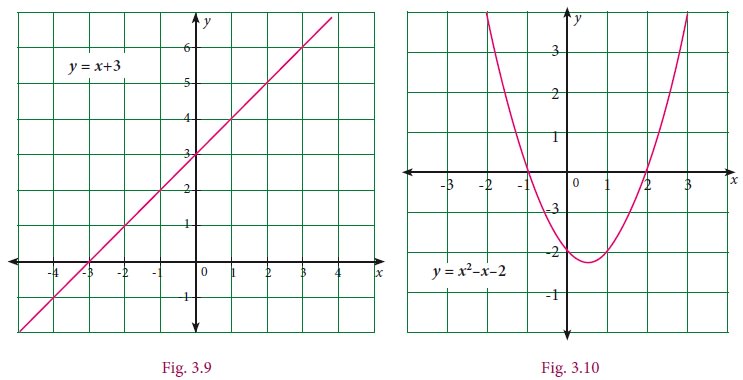
How do you plot the graph of the polynomial ? You
already know the answer. Put in different values of x and you get different values for the polynomial. If we put x=5 and calculate, we get the value of
the polynomial at x=5. In general,
the value of a polynomial p(x) at x=a,
denoted p(a), is obtained by replacing
x by a, where a is any real number.
Notice that the value of p(x) can be zero for many possible values of x (as in the second graph below). So it is interesting to ask, for
how many values of x, does p(x) become zero, and for which values ?
We call these values of x, the Zeros of the polynomial p(x).
Once we see that the values of the polynomial are
what we plot in the graph of the polynomial, it is also easy to notice that the
polynomial becomes zero exactly when the plot intersects the X-axis.
Can a polynomial p(x) have no zeros at all ? Now you have to think like a
mathematician. If a polynomial has degree 1, it is going to be of the form ax+b,
and you can solve ax+b = 0 to see that it will have some
value of x that solves the equation.
So it has one zero. What is the polynomial that has degree zero ? That means it
has only a constant, some number r.
But if r is non-zero, then it can
never have value zero ! So yes, the constant polynomial can have no zeroes at
all.
Can we argue that every polynomial p(x) with positive degree has a zero ?
That is the same as saying that every polynomial p(x) = 0 has a solution ! But this is not true, since x2 +1 = 0 has no solution in the set of real numbers. The polynomial x2+1 has only positive values, never intersects the X-axis.
So we see that a polynomial may or may not have
zeros and may have one or more zeroes. So it is very interesting, given any
polynomial, to figure out whether it has zeros or not, and how many it can
have.
Can a polynomial have infinitely many zeros ?
That is, it is a special polynomial that keeps
intersecting the X-axis again and
again and again and …. at newer and newer values of x. Now, there is a theorem that assures us that a polynomial of
degree has atmost many zeros. (We will have to learn a good deal of Mathematics
before we can prove that theorem, but when you learn you will see that it is
beautiful and worth the wait !)
We will now state all this in formal definitions.
(The number of zeros depends on the
line or curves intersecting x axis.)
For Fig. 3.9,
Number of zeros is equal to 1
For Fig. 3.10, Number of zeros is equal to 2
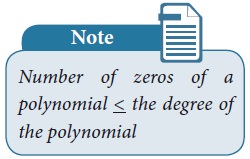
1. Value of a Polynomial
Value of a polynomial p(x) at x = a is p (a) obtained on replacing x by a (a∈R)
For example,
Consider f(x) = x3+3x-1.
The value of
f(x) at x = 2 is
f(2) = 22+3(2)-1=4+6-1=9.
2. Zeros of Polynomial
(i) Consider the polynomial p(x) = 4x3 -6x2+ 3x –14
The value of
p(x) at x = 1 is
p(1) = 4(1)3 – 6(1)2 + 3(1) –
14
= 4 – 6 + 3 –
14
= –13
Then, we say
that the value of p(x) at x = 1 is –
11.
If we
replace x by 0, we get
p(0) = 4(0)3 – 6(0)2 + 3(0)
–14
= 0 – 0 + 0
– 14
= –14
we say that
the value of p(x) at x = 0 is – 14.
The value of
p(x) at x = 2 is p(2) = 4(2)3
– 6(2)2 + 3(2) – 14
= 32 – 24 +
6 – 14
= 0
Since the value of p(x) at x = 0 is zero, we can say that 2 is one of the zeros of p(x) where p(x) = 4x3 –6x2 + 3x –14.
3. Roots of a Polynomial Equation
In general, if p(a) = 0 we say that a is zero of polynomial p(x) or a is the root of polynomial
equation p(x) = 0
Example 3.7
If f(x) = x2-4x+3,
find the values of f(1),f(-1),f(2),f(3). Also find the
zeros of the polynomial f(x).
Solution
f(x)=x2-4x+3
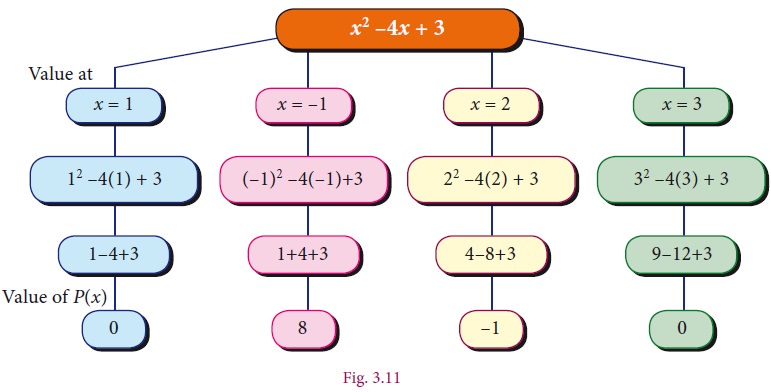
Since the value of the polynomial f(x) at x = 1 and x = 3 is zero,
as the zeros of polynomial
f(x) are 1
and 3.

Example 3.8
Find the Zeros of the following
polynomials.
(i) f(x) = 2x + 1 (ii) f(x)
= 3x – 5
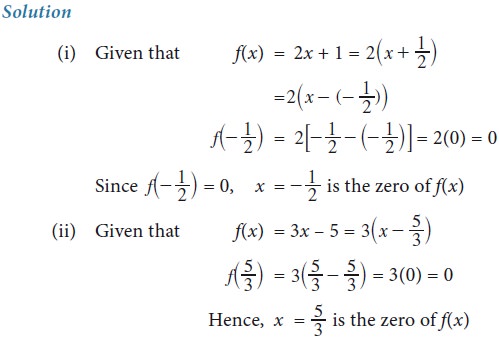
Example 3.9
Find the roots of the following
polynomial equations.
(i) 5x – 3 = 0 (ii) –7 –4x = 0
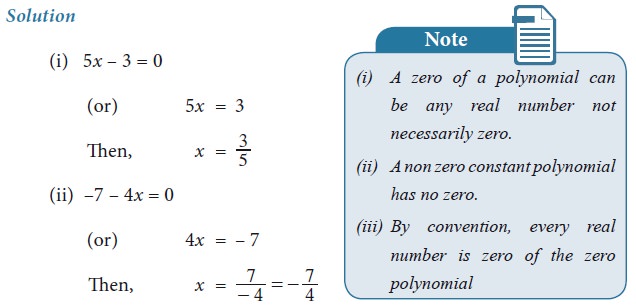
Example 3.10
Check whether –3 and 3 are zeros of
the polynomial x2 – 9
Solution
Let f(x) = x2
– 9
Then, f(–3)
= (–3)2 – 9 = 9 – 9 = 0
f(+3) = 32 – 9 = 9 – 9 = 0
-3 and 3 are zeros of the polynomial x2 – 9
Related Topics